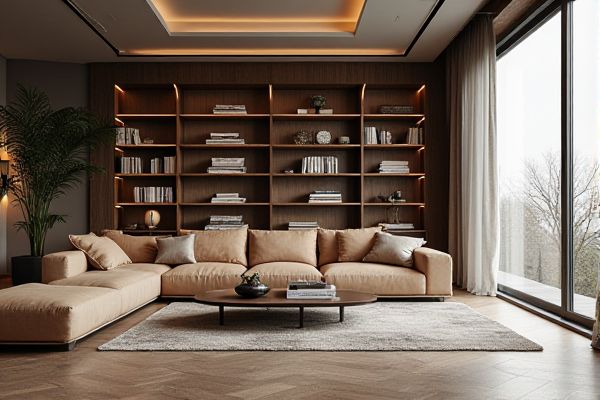
A bookcase is typically a larger, freestanding piece of furniture with multiple shelves designed to store and organize a substantial collection of books, while a bookshelf is often smaller, sometimes wall-mounted, intended for fewer books or decorative display. Exploring the differences can help you choose the perfect storage solution for your space--discover more in the full article.
Table of Comparison
| Feature | Bookcase | Bookshelf |
|---|---|---|
| Definition | Freestanding furniture unit with multiple shelves for storing books | Wall-mounted or standalone shelves designed to hold books |
| Size | Larger, often floor-to-ceiling or tall units | Smaller, more compact shelving options |
| Installation | No installation required; placed directly on floor | May require wall mounting or simple assembly |
| Material | Wood, metal, or composite materials | Wood, metal, glass, or plastic |
| Portability | Less portable due to size and weight | More portable and adaptable to different spaces |
| Uses | Primarily storage and display of books, decor | Books storage, displaying items, organizing small spaces |
| Design | Often feature enclosed backs and sides | Often open-frame design, less bulky |
Bookcase vs Bookshelf: Key Differences
A bookcase typically refers to a piece of furniture with multiple fixed shelves designed for storing a large collection of books and decorative items, often made from wood or metal. A bookshelf is generally a more compact, open unit that can be wall-mounted or freestanding, emphasizing accessibility and space-saving for fewer books. Key differences include size, structural design, and intended use, with bookcases offering sturdier storage and bookshelves catering to flexible, lightweight arrangements.
Design and Structure Comparison
Bookcases typically feature a series of fixed shelves enclosed by side panels and often include back panels for added stability, providing a sturdy, permanent storage solution. Bookshelves tend to be more open and flexible, sometimes modular, allowing for adjustable shelving heights and easier customization to fit various spaces. The design of bookcases usually emphasizes durability and weight-bearing capacity, while bookshelves prioritize accessibility and versatility in both residential and office environments.
Storage Capacity and Functionality
Bookcases typically offer greater storage capacity with multiple shelves and larger dimensions, ideal for organizing extensive collections of books, decorative items, and storage bins. Bookshelves are generally more compact and designed primarily for book storage, providing easy access and visibility while occupying less space. Both options enhance room organization, but bookcases provide more versatility for mixed storage needs.
Material Choices and Durability
Bookcases typically feature sturdy materials such as solid wood, metal, or engineered wood, offering enhanced durability and the ability to hold heavier items securely. Bookshelves often come in lighter materials like MDF or particleboard, making them more affordable but less durable over time. Your choice between a bookcase or bookshelf should consider the weight and quantity of your books, as well as the desired longevity of the furniture.
Style and Aesthetic Appeal
Bookcases offer a more substantial, built-in look that can anchor a room and serve as a focal point, enhancing your interior design with tall, multi-tiered shelving often made of wood or metal. Bookshelves tend to be lighter, more versatile pieces that provide open display space while fitting into smaller areas, perfect for adding a modern or minimalist touch to your decor. Choosing between the two depends on your style preference and the aesthetic impact you want your storage solution to make.
Space Utilization and Placement
Bookcases offer vertical storage with multiple shelves, maximizing wall space and allowing for organized display of books and decorative items in one compact unit. Bookshelves, often smaller and less tall, provide flexibility for placement in various room areas, such as nooks or atop furniture, better suited for limited spaces. Efficient space utilization depends on room size and function, with bookcases ideal for dedicated reading areas and bookshelves fitting versatile or small living environments.
Cost Considerations: Bookcase vs Bookshelf
Bookcases typically cost more than bookshelves due to their larger size, sturdier construction, and additional storage features like cabinets or drawers. Bookshelves offer a more budget-friendly option, often made from lighter materials and designed for open storage without enclosed compartments. Your choice between a bookcase and bookshelf should consider both your storage needs and budget constraints to find the best value for your space.
Assembly and Installation Differences
Bookcases typically require more complex assembly due to their larger size and multiple shelves, often necessitating wall anchoring for stability and safety. Bookshelves usually feature simpler, lightweight designs that allow for easier, tool-free assembly and do not always require installation against a wall. The choice between the two depends on the intended use, space availability, and whether permanent or portable storage solutions are preferred.
Maintenance and Longevity
Bookcases typically offer greater durability due to their solid construction and higher-quality materials, which require minimal maintenance like occasional dusting and tightening of screws. Bookshelves, often lighter and less robust, may need more frequent care to prevent warping or damage from heavy loads. Proper maintenance of both involves avoiding direct sunlight and excessive moisture to ensure longevity.
Choosing the Right Option for Your Needs
Selecting between a bookcase and a bookshelf depends on storage capacity and space constraints; bookcases typically offer multiple enclosed or open shelves with sturdy framing, ideal for larger collections and diverse items. Bookshelves are often simpler, open structures best suited for frequently accessed books and smaller spaces, emphasizing accessibility and minimalism. Assessing room size, aesthetic preferences, and book quantity helps determine the best fit for efficient organization and decor harmony.
 homyna.com
homyna.com